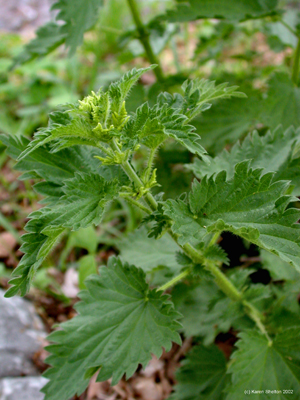Urtica dioica
| See Also | Botanical Monographs |
|---|
Nettle (Urtica dioica) is considered a general health tonic. It is a single stalk plant that stands up to 120 cm tall with heart-shaped, tooth-edged leaves. The stems are square. The flowers are white with a green cast and are borne in clusters from the leaf axils. Flowers in the male plant are more yellowish. The leaves are covered with stinging hairs as well as softer, non-stinging hairs. To differentiate them from Urtica urens (small nettle), note that the flowering panicles are longer than the leaf petioles in U. dioica. A common adulterant is the look alike plant Lamium album (white deadnettle), which does not have stinging hairs. The leaf margins of this plant are less regularly saw-toothed as well.
To explore the characteristics, medicinal uses and prescribing considerations of this herb in more detail, check out the references indicated.[1], [2]
Contents
Characteristics
- Common Names: English: Stinging nettle, Nettle, Common nettle German: Brennesselkraut, Haarnesselkraut, Hanfnesselkraut, French: Herbe d'ortie
- Family: Urticaceae
- Habitat: Urtica dioica is native to Europe especially the United Kingdom and is now naturalized in North America.
- Parts Used: Leaf, root (25% alcohol), young leaves for tea
- Main Constituents: Leaf - flavonoids, amines, carboxylic acids (in stinging hairs); Root - sterols, lectins (agglutinin (UDA): this protein is highly acid and heat resistant and therefore probably is orally absorbed (Willer, Wagner & Schecklies 1991))
- Medicinal Actions: alterative, antiallergic, mildly anti-inflammatory, astringent, galactagogue, diuretic, hypocholesterolemic, antirheumatic, tonic, rubefacient, counterirritant (fresh herb), antiprostatic
Uses
Historical Uses:
Urtica dioica has been used traditional as a cleansing tonic, in teas, soups for detoxification, and for skin conditions and allergies.
Medicinal Uses
- Urinary Conditions
- mild diuretic, helpful with benign prostatic hyperplasia as it decreases residual volume and increases urine flow. The use of Urtica dioica as an aquaretic in renal and cardiac impairment has been approved by German health officials.
- osteoarthritis, edema due to venous insufficiency, rheumatic pain (topical application), sciatica (topical), tendinitis and, sprains (topical), gout, fibromyalgia
- menorrhagia, amenorrhea, PMS
- Other Conditions
- congestive heart failure or trauma, neuralgia (topical application)
- hair loss (shampoo from infusion)
- insufficient lactation, hemorrhage
Prescribing Considerations
The information provided is intended to augment the treatment from a naturopathic doctor or other trained medical professional. Although most herbs are generally safe, it is recommended that you avoid self-prescribing especially when there is an underlying ongoing medical condition, if you are on any prescription medications or if you are pregnant or breastfeeding.
Formulations and Preparation
- Steamed (10-15 min) adult leaves with lemon juice and vinegar can be used as a food (acid helps with mineral assimilation). Note that the young leaves don't sting and thus don't need to be steamed.
- A drink could be made from lemonade, nettles and kelp.
- Decoction - 1 cup boiling water + 1-3 tsp of dried herb, infuse 10-15 minutes, take 1 cup three times daily
- Fluid extract - 1-20 drops three times daily
- Powder - 20-40 grains
- Tincture - 5-40 drops (1-4mL) three times daily; infant cholera: 1-5 drops every 1-2 hours
- Radix: decoct 4-6 g qd for BPH (cited in Tyler 1994)
- Folia: infuse 4 g in 150 ml water tid (cited in Tyler 1994)
- Juice/succus - 1-10 drops of succus used by Father Kneipp topically or orally for wounds; for warts daily for 10-12 days
Safety
The safety and prescribing considerations for this herb include:[3] [4]
- Generally regarded as safe.
- Side-effects may include: The fresh, adult leaves cause wheals due to stinging hairs. This property is actually utilized medicinally, but care must be taken in most situations. It has been found to be mildly genotoxic. It has been found to be hyperglycemic in one study in rabbits. Reported to cause minimal adverse effects on administration, except occasional GI upset.
- Cautions and Contraindications: Hypersensitivity or allergy to Urtica spp., pregnancy (use with caution due to its potent diuretic action
- Drug-Herb Interactions are rare.
References
- ↑ Boon Heather, Smith Michael (2009) 55 Most Common Medicinal Herbs: The Complete Natural Medicine Guide Second Edition Institute of Naturopathic Education and Research, CCNM Toronto.
- ↑ Godfrey Anthony, Saunders Paul, Barlow Kerry, Gowan Matt (2011) Principles and Practices of Naturopathic Botanical Medicine, Advanced Botanical Medicine. V3 CCNM Press, Toronto
- ↑ Stargrove Mitchell Bebell, Treasure Jonathan, McKee Dwight L (2008) Herb, Nutrient and Drug Interactions: Clinical Implications and Therapeutic Strategies.
- ↑ Brinker Francis (1997) Herbal Contraindications and Drug Interactions: Plus Herbal Adjuncts With Medicines, 4th Edition Eclectic Medical Publications.
